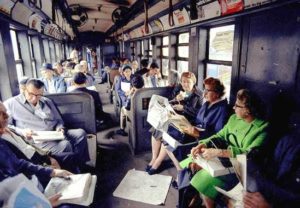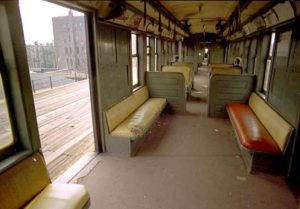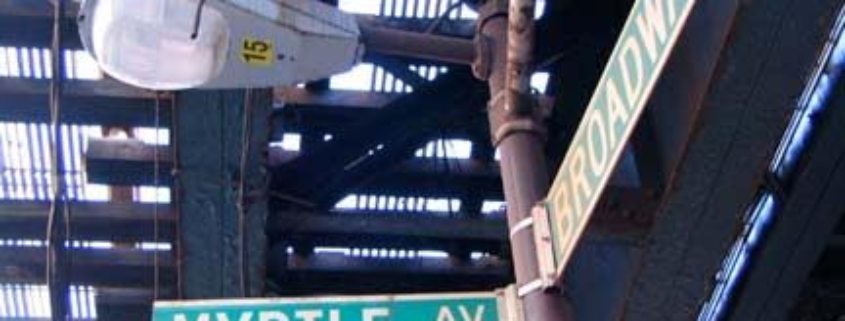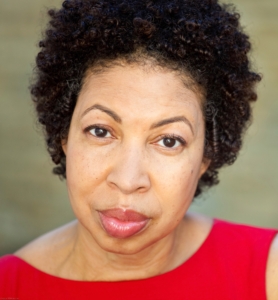Subway Home
Home is that accumulation of memory and sensation, not always sweet but invariably familiar. The familiarity is a gift which never ceases to orient me to my place in the world. As a memoirist, I draw on the abundance of this gift to excavate building blocks of story buried deep in my subconscious. My long association with New York City’s subway system offers me much opportunity to fish that subconscious well. Recently I visited family in Brooklyn. I had no reason to take a train ride. But I did anyway. You might think, Who in their right mind wants to spend one minute more than they have to in a New York City subway car?
I do.
There is something about being underground amidst the movement and noise that evokes home for me. Many years of regular exposure to this very public space, with its controlled chaos and surprising corners of tranquility, has impacted my nervous system. The subway both fueled my younger frenetic energy (I learned to move to the tempo and rhythm of the system), and provided me the space to retreat into my own mindful interior. The ceaseless stimuli honed a sense of observation, an acute alertness and worldview. No place on the planet is quite right to me if everyone there looks the same. In that way, the New York subway system played a minor role in shaping the person I’ve become as well as the writer I’m becoming.
My first rides were with family. I have an early memory of standing on an elevated platform, a train conductor patiently waiting while my mom struggled to drag my baby sister onto the train. Was it my little sister’s first ride? I’m not sure. But the sound of the train rumbling into the station, the enormity of its presence as it slowed to a stop and the doors slid open, must have appeared monstrous to her at perhaps two or three years old. She must have felt as if we were about to be consumed by some giant metal beast, and so she screamed and kicked in defiance, while the Conductor held the doors open and my young mother finally got the three of us inside.
At age twelve I began riding the Myrtle Avenue Elevated line alone. Running short errands for my mom, I took the Q Train downtown. Between the Broadway-Myrtle Avenue station—where the neighborhoods of Bedford Stuyvesant and Bushwick meet—and the downtown Bridge-Jay Street station, there were nine stops, all above ground and easy enough for an alert young girl to traverse during the day. One of the original elevated lines, the Myrtle Avenue “El” was 81 years old in 1969. The old station platforms were made of wooden slats and provided views of what remnants remained of original Brooklyn: a New England landscape peppered with church steeples. Before neighborhoods like Flatbush, Bedford Stuyvesant, Bushwick, and Williamsburg were connected, they were towns separated by farmland. Because of dwindling ridership, most of the elevated trains were discontinued in the 1970s and the above ground stations and rail tracks were disassembled overtime. The Myrtle Line was one of the first to go, closing down on October 4, 1969.*
I remember one of my very first trips alone. The ride cost twenty cents and I needed a token. (Tokens replaced coins in 1953, when the fare rose to 15 cents, since turnstiles couldn’t handle two different coins.)
“One token please—” Handing the token booth attendant my two dimes.
“You don’t plan on coming back home?” The young black man looked at me askance.
“Oh—” I said, pushing two more dimes through the slot.
“Here you go.”
“Thank you.”
Did he wink? I don’t remember. His tone was paternal and protective, the chastisement getting under my adolescent skin, just as I was beginning to chafe under my own father’s directives.
The token booths were flimsy wood and metal structures with only vertical bars separating the attendant from the public. When I picture them, I think of jail cells inside the Sheriff’s Station or Post Office booths in old Hollywood Westerns. I remember the attendants wearing coats and hats during the cold months, and running portable fans in the sweltering heat of New York City summers. The 1970s brought even more change to the system. An uptick in urban crime forced the MTA (Metropolitan Transportation Authority) to better protect its employees with bullet proof glass and air conditioning underground, while machines requiring exact change were installed on city buses.
During high school and college my confidence grew, and the subway system became a source of adventure as well as my only mode of transportation. While attending The High School of Music and Art (at that time ensconced on the City College campus at 135th Street and Convent Avenue), I traveled the A train back and forth between Harlem and Brooklyn. Riding alone most days, I occupied myself with books, but with friends, I found ways to make mischief. There were three of us from George Gershwin Junior High who had been accepted to Music and Art and we had a habit of gawking at weird, sometimes sad, sometimes unexplainable sightings below ground. One day, on a trip home, we caught notice of a derelict woman. The old woman wore a scarf wrapped around her head in an attempt to hide a large knot of some kind protruding from her skull. She watched us, three teenage girls whispering and giggling among ourselves about her appearance. Looking directly at us, the woman suddenly pulled her false teeth out of her mouth. I suppose this was her way of giving us something to laugh at. We fell to the floor convulsed in laughter, tears streaming down our faces. By the time we recovered, the woman had moved on and other commuters entering the car wondered what the hell we were laughing at.
While attending Hunter College on East 68th Street between Lexington and Park Avenues, I rode the New Lots number 2 train to Nevins, there switching to the IRT 4 or 5 to East 59th Street and Lexington. During the spring and summer, I walked the nine extra blocks. But on cold days, I waited for the local 6 Train, which made the 68th Street stop. The Upper East Side of Manhattan was a mere subway ride away from my neighborhood called East New York in Brooklyn, but in reality it was a world away. I explored the shops, restaurants, and art house movie theaters, becoming a shop girl along Lexington Avenue during my years at Hunter.
The 1970s came to symbolize the difficult days of urban decay. Labor strikes, rising crime rates and budget cuts defined a city government overwhelmed by cultural change. The Great Black Migration and White Flight transformed neighborhoods in all of the five boroughs. Subway maintenance was underfunded; trains ran with two to three non-working cars. A lack of air-conditioning in the sweltering summer heat became the norm. Delays were common. Gang tags and graffiti blanketed the underground and became synonymous with urban blight. The Straphangers Campaign, a NYC public interest research group that advocated for riders of public transport, recruited interested college students to go into the stations and begin to document the conditions. I joined. Along with others, I took notes on busted doors and out-of-service cars as filthy trains rolled into stations. I protested the dilapidated conditions in my own way as well, by refusing to pay my fare, sneaking into subway stations even though I had a school pass. My dad and I quarreled about this. An MTA bus driver, he reminded me that the only people hurt by my actions were the workers not responsible for the conditions but who would be blamed at the next labor negotiation.
In the early 80s, a receptionist by day and a drama student at night, I was seen as part of the Bridge and Tunnel crowd. That was what the yuppie set from elsewhere, all aspiring to live only in Manhattan, called the rest of us. But the joke was, they were afraid of unruly underground New York, and I was not. The system had become part of me, a place where a fair amount of living had occurred. The subway was such an intrinsic part of my existence that my life couldn’t help but play out partly below ground. Homework was completed between stops. The platforms were for lover’s quarrels, the rides home alternately providing carnival-like disruptions and opportunities for quiet reflection. I met my first husband on a city bus. The most beautiful Puerto Rican man I had ever seen. I handed him a performance flyer for “School Girl,” the a cappella group I was a member of at the time. He showed up and later he asked me on our first date while riding the IRT number 4 Train.
Days after 9/11, I cried while looking out onto the still smoldering wound from my seat on the D train as it made its way across the Manhattan Bridge. Trains closest to the disaster were allowed to resume their routes, but the stations nearest the World Trade Center remained closed. During the weeks and months of salvage and cleanup at the site, the trains slowly churned past those dark and deserted stations as we on board shared our collective grief and bore witness to their eerie quiet.
I have favorite stations. I like the Nevins Street station, downtown Brooklyn (with its easy transfer from the 2 or 3 train to the Lexington Avenue 4 and 5) for its sidewalk grating above my head that allows in sunlight on nice days but somehow manages to keep out the rain; Grand Army Plaza for its simple spaciousness and access to Prospect Park and Public Library; Grand Central Station and 42nd Street where you can transfer to almost any line and head anywhere in the City; and the N Train station stop at 57th Street and 7th near Carnegie Hall, my absolute favorite corner in Manhattan.
Men propositioned me. Others exposed themselves to me. Still others politely offered me a seat. One minute avoiding eye contact, the next carrying on conversations with total strangers. Some folk used the car as their own private living room. For a brief time, there was a rash of gold chain snatchings. Occasionally, someone jumped or got pushed in front of an oncoming train. And there were times I witnessed the most endearing moments of personal courtesy. It was an absurdist distillation of life in urban America playing out all around me underground.
If environment shapes the artist and individual, I’ve been partly shaped by life underground. My next trip home, I will travel again from my mother’s place in East Flatbush to what is called The Junction—the Nostrand/Flatbush Avenue station near Brooklyn College. Boarding a subway train on the IRT line, I’ll sink into a seat and breath in the atmosphere. Will the experience trigger a long buried memory or simply remind me of my younger self? I won’t know till then. But it’s sure to make me feel very much at home.
“Where thou art, thou is home.” Emily Dickinson
* Withering Myrtle: The Last Days of the Myrtle Avenue El. – Forgotten New York
Angela Bullock is an actor/writer pursuing an MFA in Creative Nonfiction at Antioch University LA.






